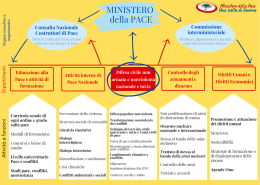““By Sharing our lifes with disable people, drug addicts and minors without families, we try to get their voices everywhere, especially to those who have the power to liberate and oppress. (…) Of so many existing ministries, I would have liked you to have added another one: the Ministry of Peace. Men have always organized the war. The time has come to organize peace “
Letter to the President of the Council – Year 2001
Don Oreste Benzi – Founder Community Pope John XXIII
Peace is one of the raison d’être of the UN system as it clearly emerges from the historical facts that led to the creation of the United Nations Organization and from the UN Charter. Given its relevance, peace has always been at the centre of the UN work and during the last decades some Member States and civil society organizations have striven for the recognition of the right to peace. This process has finally led to the adoption of the 2016 UN General Assembly Resolution A/RES/71/189 “Declaration on the Right to Peace”. We have no intention to hide that the formulation of such a right has been a non-consensual process and Member States still have divergent positions on the matter.
Our idea of the Ministry of Peace finds its origin in the thought of the founder of our community APG23, Don Oreste Benzi, and was then elaborated and deepened over the years by our association. Don Oreste Benzi claimed the establishment of a Ministry of Peace in 1994 in an open letter to the Italian government. He believed that since men have always been organizing wars, it was high time to organize peace and the Ministry of Peace should be tasked precisely with this mission. Taking Don Oreste Benzi’s thought as an inspiration, in 2017 APG23 launched a national campaign to promote the establishment of a Ministry of Peace in Italy; this national campaign has received a great support from many other Italian civil society organizations and academia. APG23 continues its campaign and its advocacy efforts in Italy for the creation of a Ministry of Peace.
The goal of the following document is to propose a way forward in the Declaration on the Right to Peace implementation and more generally in the achievement of a lasting and sustainable peace. Based on art. 3 of Declaration on the Right to Peace, which calls for “appropriate sustainable measures to implement the present Declaration”, we develop our idea about what type of measure can be taken to implement peace.
The Human Rights Council (HRC) is the right place to push for such efforts. Given the concept of peace that will be outlined in this document and its strong relationship with human rights, which is also recognized by General Assembly resolution 60/251 establishing the Human Rights Council, the HRC can and should deal with the right to peace and its constitutive elements and this work would not constitute a duplication or interference with the mandate of other UN institutions. Indeed, since peace and human rights are mutually reinforcing, by dealing with and implementing the right to peace and its content, the HRC is fulfilling its mandate of promoting human rights and addressing situations of human rights violations. Vice versa, by promoting human rights and addressing situations of human rights violations, it contributes to the achievement and maintenance of peace – a UN goal.



